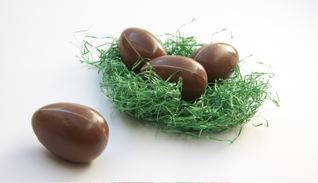 Springtime conjures up images associated with the season of specialty chocolate bunnies, Easter chocolate eggs, and more.
Springtime conjures up images associated with the season of specialty chocolate bunnies, Easter chocolate eggs, and more.
Easter is coming on March 31, 2013 (except for those who belong to the Eastern Orthodox Church and celebrate it on May 5, 2013). Image of chocolate eggs courtesy of gesinek at rgbstock.com.
As Lent ends, often consumers look at engaging in some type of chocolate indulgence.
Those of the Jewish faith in the USA who celebrate Passover from sunset on March 25, 2013 through April 2, 2013 may also consider a Kosher chocolate indulgence as well.
If chocolate has been properly stored, then the item(s) should have no “chocolate bloom” once any packaging is opened. If it has been improperly stored, however, then “chocolate bloom” may be evident.
Will that chocolate bloom put a damper on the experience?
A whitish haze, called “chocolate bloom,” may appear on the surface of various chocolate types including dark, bitter-sweet or semi-sweet, milk, or even unsweetened chocolate. This bloom is caused by either the cacao butter aka cocoa butter and/or sugar rising to the surface, often due to exposures to high temperatures or sunlight (say due to being stored in a car with issues of the “green house effect” coming through car windows) and then the cooling off of the chocolate.
The presence of chocolate bloom has NOTHING to do with the safety aspect of eating the item as food technologists remind us–it only affects its appearance.
The quality of the chocolate has likely been affected due to such fluctuations in its storage. If stored improperly, realize that the item may not “taste” the same nor have the same “creamy” mouthfeel texture it previously had.
Some Details About Various Types of Chocolate to Keep in Mind:
- Dark types contain at least 35 percent cocoa liquor aka chocolate liquor;
- Dark types may contain magnesium, copper and some other trace elements, along with the flavanols catechin and epicatechin (from the flavonoids category of antioxidants);
- Dark types have caffeine; white types do not intrinsically contain caffeine;
- Dairy-based “milk” types may provide some calcium & protein;
- Milk types contain at least 10% cocoa liquor aka chocolate liquor;
- White or pastel colored types contain NO cocoa liquor aka chocolate liquor, must contain at least 20% cocoa butter, and should contain no more than 55% sugar content.
How to Best Protect Your Chocolate Indulgence:
- Buy fresh, higher quality darker types in much smaller amounts and don’t attempt to store it for later use;
- If you must store chocolate, don’t do so in your car as likely it is too hot or too cold in there;
- Keep it at a constant temperature, close to comfortable room temperature (68—74 degrees Fahrenheit) or slightly cooler. Most types like to be stored at a constant temperature somewhere between a low of 60-62 degrees F and a high or no more than 74 degrees F;
- Do NOT refrigerate or freeze any types thinking you can accomplish longer term storage that way.
Particularly if you purchase “artisan” prepared chocolate from a local chocolatier, the item is meant to be consumed in shall we say a timely manner.
 Think of consuming actual chocolate as a small, sensory packed experience to be savored while it is still optimally fresh, particularly if more perishable fruit, etc., has been incorporated into the delicacy. Image of chocolate covered strawberry courtesy of crazeeoutoflove10 at photobucket.
Think of consuming actual chocolate as a small, sensory packed experience to be savored while it is still optimally fresh, particularly if more perishable fruit, etc., has been incorporated into the delicacy. Image of chocolate covered strawberry courtesy of crazeeoutoflove10 at photobucket.
If you do indulge in chocolate this spring as Easter arrives and Lent ends, or to celebrate Passover, etc., our suggestion would be to buy less of the best and enjoy it more!

